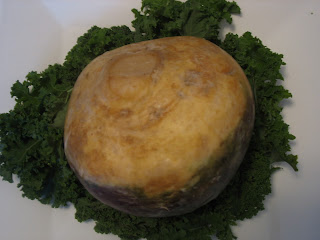
Rutabaga, or what some people (incorrectly) call turnip, is one of the least expensive vegetables available right now. And with the big jump in food costs, a cheap vegetable is rare. But, let's be honest, the rutabaga is not one of the most flavourful vegetables and cutting through it can lead to serious injury. And how healthy is it anyway? Is it even worth the effort to eat?
Let's take a look at the 'health value' first. There is no official definition of 'health value' that I'm aware of, however, if you're looking for something that's low in sodium and a source of fibre, rutabaga is your vegetable (just like almost all veggies and fruit!). To be honest, it isn't a nutritional powerhouse of any vitamin or mineral but it beats celery and cucumber in most aspects, and has more Vitamin C than carrots, apples, zucchini and mushrooms. Grant it, rutabaga has much less Vitamin A than some dark green leafy vegetables like kale and spinach and orange vegetables like sweet potato and butternut squash but so do many other vegetables. When you compare it's potassium, iron, calcium, folate and magnesium content to a variety of other vegetables, rutabaga holds it's own. To me, all of this means that with respect to 'health value', the rutabaga is indeed worth the effort. Like all other vegetables (and fruit) eating a variety of them does the body good. And more variety makes eating more interesting.
So, in terms of cost and nutrition, rutabaga is worth the effort. What about it's flavour? When I was growing up, the only way I would tolerate rutabaga was when it was boiled and mashed with tons of butter and brown sugar. Most anything tastes good that way. Lately, I've expanded my rutabaga cooking horizons and tried it many different ways. I've sampled the different ways with friends and colleagues. My tasters and I had it baked with apples, steamed with lemon and butter, roasted with olive oil and rosemary and raw rutabaga sticks with dip. All were accepted but guess how most of us preferred it...raw. The humble rutabaga makes a great addition to your veggie tray. When I served it raw, I had grated some for little kids to try. One of my tasters and colleagues suggested that grated, it would work great in coleslaw. So, I gave it a try and she was right.
I adapted a recipe from Foodland Ontario to make the coleslaw with rutabaga. It includes inexpensive vegetables available in winter: cabbage, carrots, onion and rutabaga.
To make 4-6 servings, use half the cabbage, half of the rutabaga, 1 carrot and 1 onion,
Shred the cabbage or slice very thinly.
Dice the onion.
Grate the carrot and rutabaga.
Combine the vegetables in a large bowl.
Make the dressing:
In a microwaveable dish mix:
125 ml (1/2 cup) cider vinegar
1/4 cup (50 ml) maple syrup
1/4 cup (50 ml) vegetable oil
Add seasonings:
5 ml (1 tsp) each of dried dill, dry mustard, garlic powder or minced garlic
2 ml (1/2 tsp) salt and pepper
Microwave on high for about 90 seconds until hot but not boiling.
Pour the hot dressing over the vegetables and toss well. Let the coleslaw sit for bit before serving to soften the vegetables and impart flavour. This will keep in the fridge for a few days.
The remaining rutabaga and cabbage will keep for a while in the fridge. Use the rutabaga in a roasted vegetable dish or grate some and add to other salads or use as a sandwich topping for a nice crunch instead of expensive lettuce. Use the cabbage in a soup like Cabbage and Potato Soup (http://diariesofadietitian.blogspot.ca/2014/12/simply-delicious-cabbage-potato-soup.html)
Michele Hurd, RD





I am a lover of rutabaga and other than roasting or boiling it, I've never given much thought to using it in another way. Thanks for another great recipe! :-)
ReplyDeleteWe hope that you enjoy it!
DeleteShannon RD